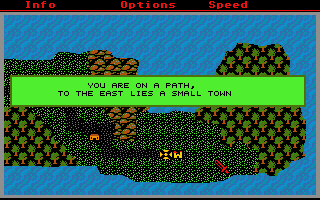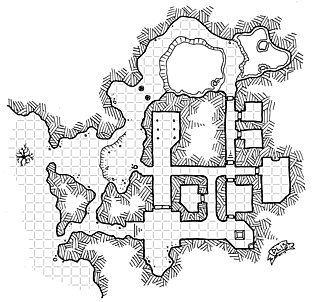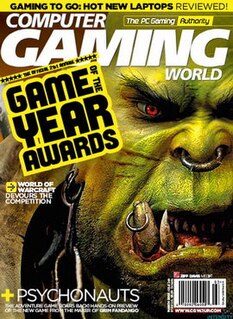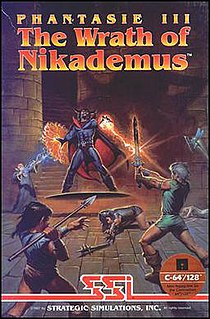
Eye of the Beholder is a role-playing video game for personal computers and video game consoles developed by Westwood Associates. It was published by Strategic Simulations, Inc. in 1991 for the DOS operating system and later ported to the Amiga, the Sega CD, Game Boy Advance and the SNES. The Sega CD version features a soundtrack composed by Yuzo Koshiro. A port to the Atari Lynx handheld was developed by NuFX in 1993, but was not released.

Temple of Apshai is a dungeon crawl role-playing video game developed and published by Automated Simulations in 1979. Originating on the TRS-80 and Commodore PET, it was followed by several updated versions for other computers between 1980 and 1986.

Wizard's Crown is a 1986 top-down role-playing video game published by Strategic Simulations. It was released for the Atari 8-bit, Atari ST, IBM PC, Apple II and Commodore 64. Its sequel, The Eternal Dagger, was released in 1987.

Roadwar 2000, sometimes referred to as Roadwar 2K, is a 1986 computer game published by Strategic Simulations, Inc.. It is a turn-based strategy game set in a post-apocalyptic future which resembles the world portrayed in the Mad Max movie series. As of 2003 the game is out of stock.

HardBall! is the first in a series of popular baseball computer and video games published by Accolade. It was released for a variety of platforms between 1985 and 1991. The game was followed by sequels HardBall II, HardBall III, HardBall IV, HardBall 5, and HardBall 6.

Might and Magic IV: Clouds of Xeen is the fourth installment in the Might and Magic series by New World Computing.

Plundered Hearts is an interactive fiction computer game created by Amy Briggs and published by Infocom in 1987. It was released simultaneously for several popular computer platforms of the time, such as the PC and Commodore 64. Plundered Hearts was Infocom's first game in the "romance" genre. It is Infocom's twenty-eighth game.

Winter Games is a sports video game developed by Epyx, based on sports featured in the Winter Olympic Games.
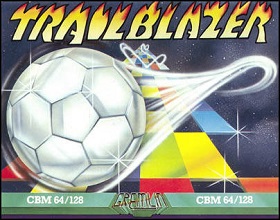
Trailblazer is a video game that requires the player to direct a ball along a series of suspended passages. Released originally by Gremlin Graphics for the ZX Spectrum, Commodore 64, Atari 8-bit family, Amstrad CPC and C16/plus/4 in 1986. It was ported to the Amiga and Atari ST.

The Eternal Dagger is a 1987 top-down role-playing video game published by Strategic Simulations, Inc. (SSI) as a sequel to Wizard's Crown, which was released in 1986. Players can transfer their characters over from Wizard's Crown, minus whatever magical items they had on them.

Hard Nova is a role-playing video game developed by Malibu Interactive and published by Electronic Arts in 1990 for MS-DOS, Amiga and Atari ST. It is a follow-up to Sentinel Worlds I: Future Magic.

Champions of Krynn is role-playing video game, the first in a three-part series of Dragonlance Advanced Dungeons & Dragons "Gold Box" games. The game was released in 1990. The highest graphics setting supported in the MS-DOS version was EGA graphics. It also supported the Adlib sound card and either a mouse or joystick.

Moebius: The Orb of Celestial Harmony is a video game produced by Origin Systems and designed by Greg Malone. It was originally released in 1985 for the Apple II series of personal computers. Versions were also released for the Amiga, Atari ST, Commodore 64, Macintosh, and MS-DOS. The game is primarily a top-down view tile-based role-playing video game, but it has action-based combat sequences which use a side view, roughly similar to games such as Karateka.

Realms of Darkness is a fantasy video game developed by Strategic Simulations and released in 1986. It was developed for the Apple II and Commodore 64.
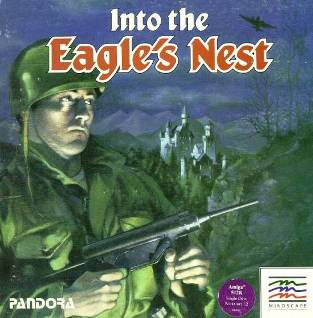
Into the Eagle's Nest is a computer game developed by Pandora and published for Amiga, Amstrad CPC, Apple II, Atari 8-bit family, Atari ST, Commodore 64, IBM PC and ZX Spectrum starting in 1987.

Alternate Reality: The City is a video game published by Datasoft, the first game in the Alternate Reality series. It was created by Philip Price, and was released in 1985. Gary Gilbertson created the music.

